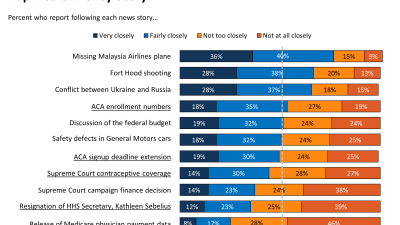 Kaiser Health Policy News Index: April 2014
Poll Finding
Kaiser Health Policy News Index: April 2014
Poll Finding
The Kaiser Health Policy News Index is designed to help journalists and policymakers understand which health policy-related news stories Americans are paying attention to, and what the public understands about health policy issues covered in the news. This month’s Index finds that the public followed the missing Malaysia Airlines flight, the shooting at the Fort Hood army post, and the conflict between Ukraine and Russia, more closely than any health policy news stories. Among health policy news, the most closely-followed story was coverage of how many people have enrolled in health insurance options under the Affordable Care Act (ACA), which just over half the public reports following “very” or “fairly” closely.